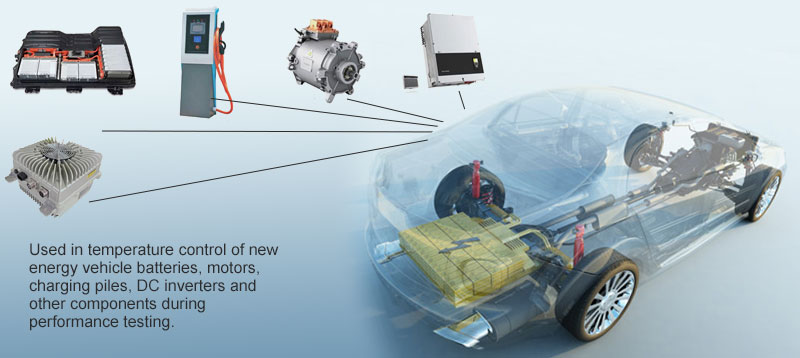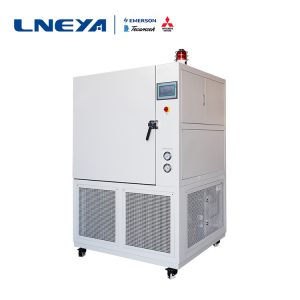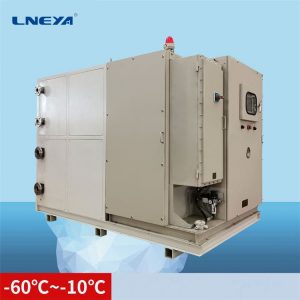L'effetto del sistema di simulazione della temperatura di prova della batteria sui test di raffreddamento dei veicoli elettrici/ibridi
Nel settore dei veicoli elettrici, le batterie sono una parte importante delle automobili e le loro prestazioni influiscono direttamente sulle prestazioni dei veicoli ibridi/elettrici. Per questo motivo, i principali produttori del mercato hanno lanciato un sistema di simulazione della temperatura di prova del sistema di raffreddamento della batteria per eseguire in modo efficiente i test di carica e scarica dei moduli della batteria.
A causa dello spazio limitato del veicolo, l'accumulo di calore generato durante il funzionamento della batteria causerà ovunque una temperatura non uniforme e influirà sulla consistenza delle celle della batteria. Ciò riduce l'efficienza del ciclo di carica e scarica della batteria, influisce sulla potenza e sull'energia della batteria e, nei casi più gravi, porta anche alla fuga termica, con conseguenze sulla sicurezza e sull'affidabilità del sistema. Per migliorare le prestazioni e la durata del pacco batteria, è necessario che la batteria sia gestita termicamente per controllare la temperatura del pacco batteria entro un intervallo ragionevole.
Il sistema di gestione termica della batteria è una delle tecnologie chiave per affrontare i problemi termici della batteria e garantire le prestazioni, la sicurezza e la durata della batteria di potenza. Le funzioni principali del sistema di gestione termica comprendono: un'efficace dissipazione del calore quando la temperatura della batteria è elevata per evitare incidenti di fuga termica; il preriscaldamento quando la temperatura della batteria è bassa, l'aumento della temperatura della batteria, la garanzia delle prestazioni di carica e scarica e la sicurezza alle basse temperature; la riduzione della differenza di temperatura all'interno del pacco batteria, la soppressione della formazione di punti caldi locali, la prevenzione di un decadimento troppo rapido della batteria nei punti ad alta temperatura e la riduzione della durata complessiva del pacco batteria.
La temperatura all'interno del pacco batteria (PACK) ha una grande influenza sull'affidabilità, la durata e le prestazioni della cella della batteria. Pertanto, è particolarmente importante mantenere la temperatura all'interno del PACK entro un certo intervallo di temperatura. Il raffreddamento ad aria è un metodo di dissipazione del calore che utilizza l'aria a bassa temperatura come mezzo e sfrutta la convezione termica per ridurre la temperatura della batteria. Si distingue in raffreddamento naturale e raffreddamento forzato (utilizzando una ventola, ecc.). La tecnologia di raffreddamento a liquido utilizza lo scambio termico per convezione di liquidi per rimuovere il calore generato dalla batteria e ridurne la temperatura. Il mezzo liquido ha un elevato coefficiente di trasferimento del calore, una grande capacità termica e una rapida velocità di raffreddamento. Ha un effetto significativo sulla riduzione delle temperature più elevate e migliora la coerenza del campo di temperatura del pacco batteria. Allo stesso tempo, il volume del sistema di gestione termica è relativamente ridotto. Il raffreddamento diretto (refrigerante diretto) utilizza il principio del refrigerante (R134a, ecc.) per far evaporare il calore latente, creare un sistema di condizionamento dell'aria nel veicolo o nel sistema della batteria, installare l'evaporatore del sistema di condizionamento dell'aria nel sistema della batteria, e il refrigerante evapora nell'evaporatore e rimuove rapidamente ed efficacemente il calore dal sistema della batteria per completare il raffreddamento del sistema della batteria.
I problemi legati al calore della batteria sono i fattori chiave che ne determinano le prestazioni, la sicurezza, la durata e il costo. Il sistema di ciclo di raffreddamento di prova è un'apparecchiatura di prova essenziale per i veicoli a nuova energia, i moduli della batteria e i test di raffreddamento del liquido del PACK della batteria. Test del motore e del suo controllore. Il sistema di simulazione della temperatura di prova del sistema di raffreddamento della batteria LNEYA promuove efficacemente lo sviluppo delle prestazioni, della sicurezza e della durata delle batterie di potenza.
Raccomandazioni correlate
-
Descrizione della temperatura del refrigeratore di glicole
1519Per gli utenti e gli amici è necessario conoscere a fondo i refrigeratori a glicole prima dell'uso. Si raccomanda di conoscere la temperatura delle varie apparecchiature, come il sistema di refrigerazione, la temperatura di evaporazione e la temperatura di condensazione, ecc.
Visualizza dettagli -
What are the price factors affecting 60P freezers?
1735When users choose 60P freezers, they are very concerned about the price. Then the factors affecting the price, Wuxi Guanya (LNEYA) need to make everyone understand. The freezer brand is an important intangible asset of a company or product, and is...
Visualizza dettagli -
Vocs gas condensation recovery unit processing instructions
1990With the continuous inspection of environmental protection, Wuxi LNEYA VOCS gas condensation recovery device has also received continuous attention from the public. Most chemical, pharmaceutical and industrial industries are urgently dealing with ...
Visualizza dettagli -
Commissioning of circulating water chiller equipment for chemical enterprises
1624After completing the installation of circulating water chillers in chemical enterprises, certain debugging needs to be carried out for industrial chemical circulating water chillers in the early stage of operation. Only through careful debug...
Visualizza dettagli
 Refrigeratori industriali LNEYA Produttore Fornitore
Refrigeratori industriali LNEYA Produttore Fornitore















